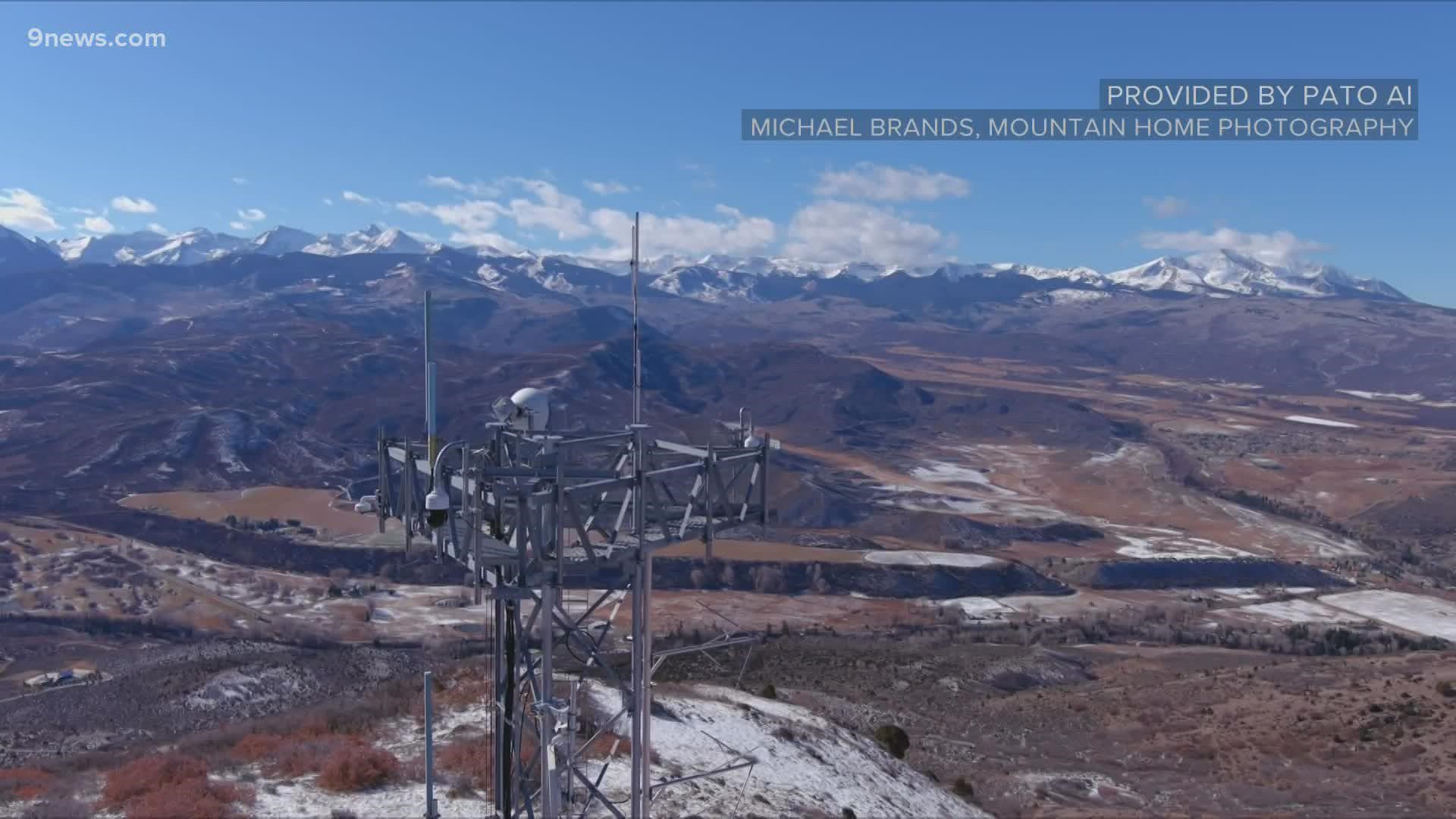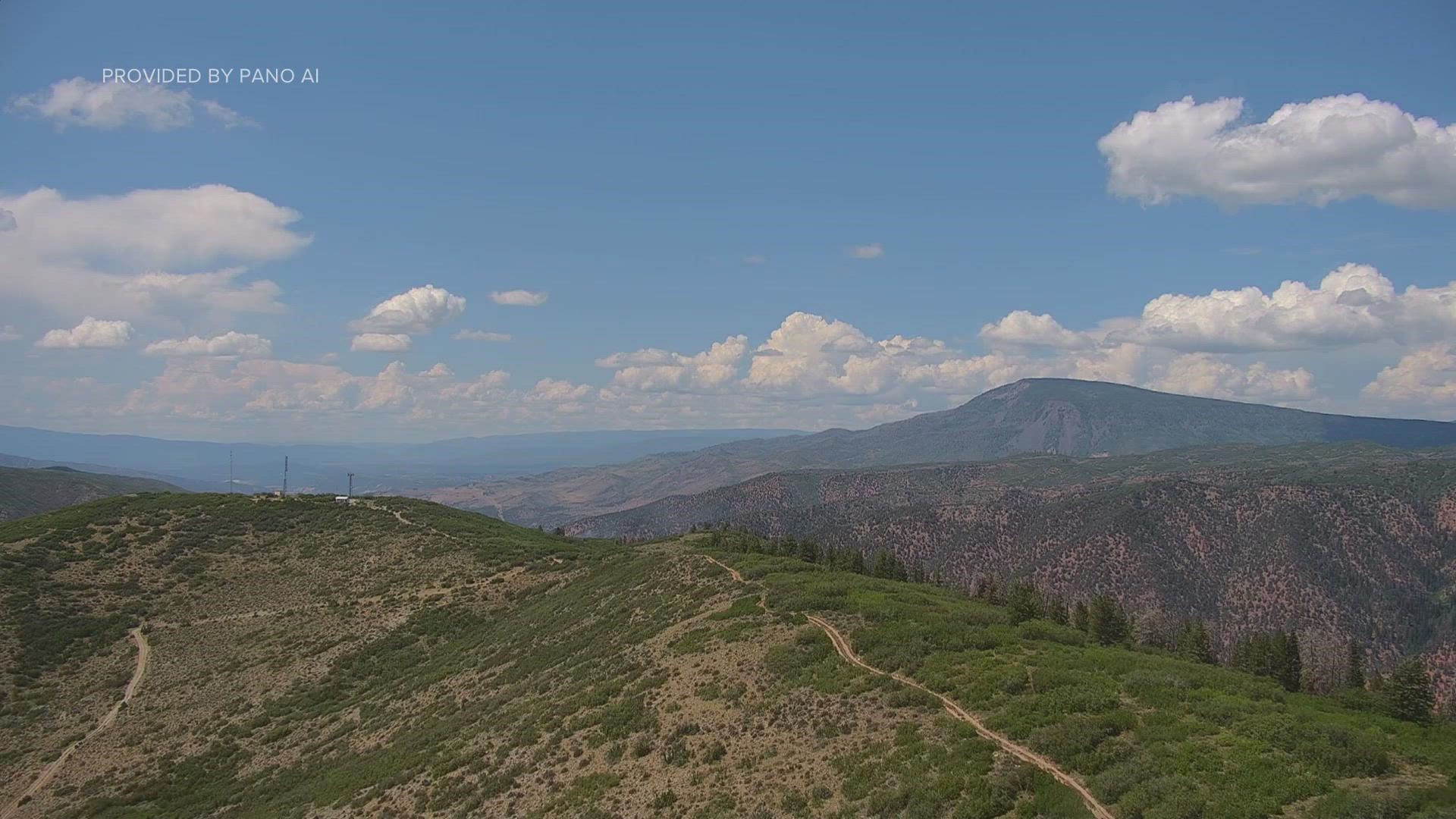ASPEN, Colo. — For most of his career, the only way Rick Balentine could get early eyes on a wildfire was to get someone there in person.
Today, within seconds, the chief of the Aspen Fire Protection District can pull up a program on his computer from his office in Aspen. With just a few clicks, he has a 360-degree view of the mountains throughout his district, including virtual smoke reports.
“This camera on top of Ajax, this is looking back towards town,” Balentine said, clicking through a recent demonstration of the technology. “We’ve had lightning strikes here above Red Mountain in the past.”
His district includes nearly 90 square miles, plus partnerships with other nearby departments and the U.S. Forest Service – with a lot of rugged terrain and backcountry.
“It [can] take a long time to get from point A to point B,” Balentine said. “Anytime we can shorten the response time by technology, that’s going to help us along, help our neighbors and help us when we need help, too.”
Cameras sit on top of four lookout points near Aspen. It's part of a pilot project Aspen entered in July with a California-based company, Pano AI.
Each lookout point has two high-definition cameras that scan a 360-degree view, turning a full rotation once every minute. Using artificial intelligence, the cameras work to detect smoke across the landscape.
"It's funny, my wife called it 'smoke detectors in the sky,' " Balentine said.


Pano AI is pitching the program as a solution to early wildfire detection, catching fires before they blow up, in areas that are often hard to reach and respond to.
“Every large fire starts as a small fire,” said Arvind Satyam, Pano AI’s chief commercial officer.
“What we do as a company is really provide the ability to detect smoke and detect incidents as quickly as possible and really provide actionable intelligence – visual intelligence to fire authorities where they’re able to confirm the incident, call in aerial attack if needed," Satyam said.
Satyam’s team sees this as a solution for more than just firefighters. They said utility companies and the insurance industry could also benefit.
“For us, being able to quickly and accurately detect and inform stakeholders makes it safer for them to respond and gives them the actual intelligence to respond with the right amount of resources,” he said.
The program combines artificial intelligence with human intelligence. When the cameras detect possible smoke, real people working out of Pano’s intelligence center work to validate those reports.
Once verified, notification is sent to partners – like the Aspen Fire Protection District – that will not only see the smoke alert from their camera view but also get a location. Through the multiple cameras, Pano is able to triangulate more precise locations for responding crews.
> Watch: Pano AI video from Aspen
Pano AI has also considered privacy concerns. Satyam said the technology pixelates any part of the view overlooking private property and any private property visible through the zoom function – including homes and other structures.
Pano AI is testing cameras throughout California and Montana, too.
The pilot project allows the artificial intelligence to learn information about smoke detection, including what’s real smoke and what isn’t. The technology isn’t perfect yet and is collecting and learning data every day.
Colorado’s colorful landscape has been a helpful teacher.
“This company is from California, and what they found was, when the trees started changing color [here], the camera kind of went – ‘Oh my gosh, what is that?’” Balentine said with a laugh.
He said the cameras had learned that, in Colorado, autumn’s vibrant leaf colors are normal and not a potential fire.
Colorado also helped the artificial intelligence learn the difference between white smoke and white snow.
“If you can imagine, the Napa and Sonoma county backdrop is going to be very different from what we’re seeing in Pitkin County,” Satyam said.
“Today we're seeing a backdrop where you’ve got smoke incidents that are being picked up where there’s peaks covered by snow," Satyam said. "And that’s not what we’re seeing in Northern California or Southern California. So Colorado has played a really important role in helping train the AI."
“One of our hopes with this is that we can help them build this system to a point where it becomes wildly available so that it can be employed widely throughout the country,” said Jake Andersen, Aspen Fire’s deputy chief of operations.
“We can't overstate that the fire problem in the state of Colorado has changed so dramatically over the past 20 years," he said. "We need to explore new options to solve a problem that's very different than when I started.”
Fires are getting bigger and more destructive across Colorado. In 2020, two fires became the state’s largest on record: the Cameron Peak Fire in Larimer County and the East Troublesome Fire in Grand County.
The Lake Christine Fire burned in Pitkin County in 2018, destroying three homes and forcing hundreds of people to evacuate from their homes.
“For us, the reason we see value in this technology is the earlier we know about something, the greater the chance we have to catch it before it becomes a big problem,” Andersen said.
Balentine said he's excited about the technology, and grateful it has – so far – been a quiet fire season in Pitkin County.
“The fact that it could have saved lives or property, to me it’s worthwhile,” he said.
Balentine said he was initially hesitant to spend public dollars on a pilot program. Aspen Fire said a private landowner who lives in the area and is interested in wildfire prevention donated $50,000 for the first year.
The trial was planned to run from July through November in Aspen, and fire department leaders were planning to reconnect with Pano AI in December to review the project and discuss what happens next.
Pano is also looking to the future. Satyam said the company is trying to figure out what each stakeholder needs, whether they are first-responders, utility companies or insurance companies.
“Our goal is really to build functionality that addresses the needs of each of these stakeholders,” Satyam said. ”And what we’ve been trying to do during the course of this season, and going forward, is understand what that business model is that really allows us to go scale across multiple areas and also really work and address the needs of each of these stakeholders.”
As the pilot program draws to a close in Aspen, firefighters are optimistic this could work.
“When we went into it, we had no idea if it was going to have any value or not. It seemed like a good idea,” Andersen said. “I think it's definitely demonstrated some value. There’s definitely some growth still to be had. But I think this is definitely moving toward the future, and I’m betting within a couple years this will be something that can be useful for a broad variety of people – not just in this state, but the entire West.”
“As far as I’m concerned, I’m all in,” Balentine said. “I think this is the future.”
SUGGESTED VIDEOS: Wildfires in Colorado


